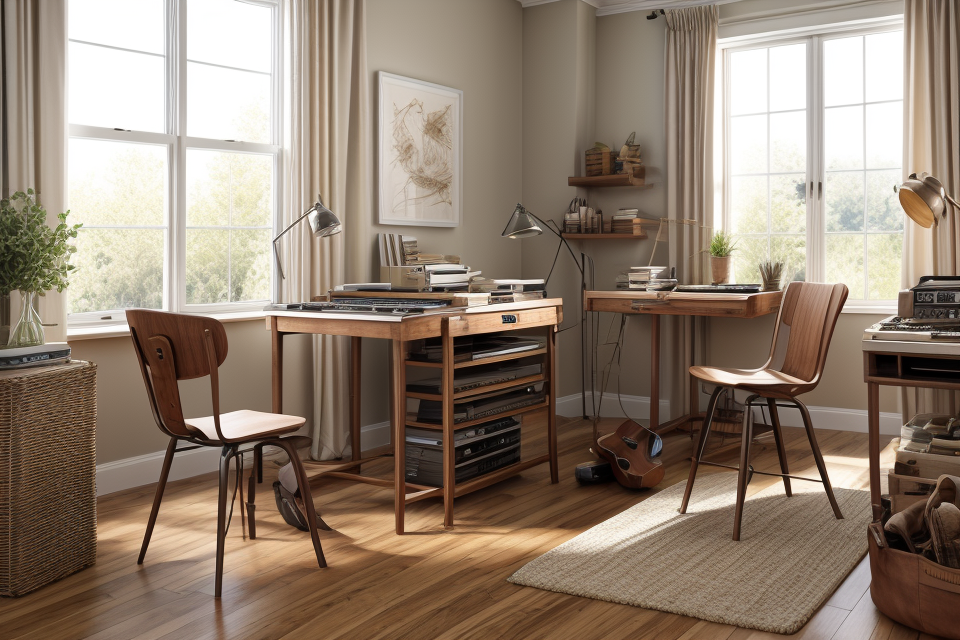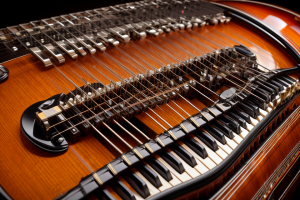
The music industry is a vast and vibrant world, full of talented musicians, producers, and instrument designers. While many people are familiar with the role of a musician or producer, the role of an instrument designer may not be as well-known. However, instrument designers play a crucial role in the music industry, creating the tools that musicians use to express themselves and create their music. In this article, we will explore the role of an instrument designer in the music industry, including their responsibilities, skills, and the impact they have on the music world. Whether you’re a musician, producer, or simply a music lover, read on to learn more about the fascinating world of instrument design.
The role of an instrument designer in the music industry is to create and develop new musical instruments or improve upon existing ones. This involves a deep understanding of acoustics, materials, and construction techniques, as well as knowledge of the musical needs and preferences of players. Instrument designers work with luthiers, engineers, and other professionals to create prototypes, test new designs, and refine their creations. They may also collaborate with musicians and composers to understand the unique demands of different genres and styles of music. Ultimately, the goal of an instrument designer is to create tools that enable musicians to express themselves and their artistry to the fullest extent possible.
Understanding the Basics of Instrument Design
The Definition of an Instrument Designer
An instrument designer is a professional who is responsible for the creation and development of musical instruments. This role involves a deep understanding of acoustics, materials science, and engineering principles, as well as a keen sense of aesthetics and craftsmanship. The instrument designer is responsible for designing and developing new instruments, as well as improving existing ones, in order to produce high-quality sound and provide musicians with the best possible tools for their craft.
The History of Instrument Design
Instrument design is a fascinating aspect of the music industry that has evolved over the centuries. The evolution of musical instruments has been influenced by various factors, including technological advancements, cultural changes, and the creative vision of instrument designers. In this section, we will explore the history of instrument design and how it has shaped the music industry as we know it today.
The evolution of musical instruments
The earliest musical instruments were simple and made from natural materials such as wood, bone, and animal horns. These instruments were often used in rituals and ceremonies and were not designed for a specific pitch or key. Over time, as civilizations developed, so did the instruments used in music-making. Ancient civilizations such as the Greeks and Romans developed more complex instruments, such as the lyre and the lute, which were designed to produce specific pitches and melodies.
As music evolved, so did the instruments used to create it. During the Renaissance period, instrument designers began to experiment with new materials and designs, resulting in the creation of new instruments such as the violin and the harpsichord. These instruments were designed to produce a wider range of sounds and were more versatile than their predecessors.
Instrument design through the ages
Throughout history, instrument design has been influenced by a variety of factors, including cultural and artistic movements. For example, during the Baroque period, instrument designers focused on creating instruments that could produce a more expressive and dynamic sound, such as the violin and the cello. In contrast, during the Classical period, instrument designers focused on creating instruments that were more precise and accurate, such as the piano.
In the 19th and 20th centuries, instrument design underwent significant changes due to technological advancements. Instrument makers began to use new materials, such as metals and synthetic resins, to create instruments that were more durable and capable of producing a wider range of sounds. They also began to use new manufacturing techniques, such as machine cutting and computer-aided design, to create instruments that were more precise and consistent.
Overall, the history of instrument design is a rich and fascinating one that has played a crucial role in the development of the music industry. From simple, natural instruments to complex, technologically advanced instruments, the evolution of musical instruments has allowed musicians to express themselves in new and innovative ways, shaping the sound of music as we know it today.
The Responsibilities of an Instrument Designer
Designing New Instruments
Designing new instruments is one of the primary responsibilities of an instrument designer in the music industry. This involves creating new and innovative musical instruments that can enhance the overall sound quality and playing experience for musicians.
The process of designing a new instrument
The process of designing a new instrument involves several steps, including research, concept development, prototyping, testing, and final production. An instrument designer must have a deep understanding of music theory, acoustics, and materials science to create an instrument that produces the desired sound and feels comfortable to play.
The first step in designing a new instrument is research. An instrument designer must research existing instruments to identify areas for improvement or to create something entirely new. This involves studying the design, construction, and materials used in existing instruments, as well as the playing techniques used by musicians.
The next step is concept development. Based on the research, the instrument designer must develop a concept for the new instrument. This involves sketching designs, creating models, and selecting materials. The designer must also consider the desired sound, playing technique, and overall aesthetic of the instrument.
Once the concept is developed, the instrument designer must create a prototype. This involves building a working model of the instrument to test its design and sound. The prototype may go through several iterations as the designer makes adjustments to the design based on feedback from musicians and other experts.
The final step in the design process is testing. The prototype is tested by musicians to ensure that it produces the desired sound and feels comfortable to play. Feedback from musicians is crucial in refining the design and making any necessary adjustments.
The challenges of designing a new instrument
Designing a new instrument is a complex process that involves many challenges. One of the biggest challenges is creating an instrument that produces a unique and desirable sound. This requires a deep understanding of acoustics and the physics of sound production.
Another challenge is ensuring that the instrument is comfortable to play. This involves designing the instrument to fit the physical characteristics of the musician, such as hand size and playing technique. The instrument designer must also consider the materials used in the instrument, as different materials can affect the sound and feel of the instrument.
Finally, the instrument designer must balance the need for innovation with the need for tradition. Musical instruments have a rich history and tradition, and musicians often have strong preferences for certain designs and materials. The instrument designer must respect this tradition while also introducing new and innovative features to the instrument.
Modifying Existing Instruments
The process of modifying an existing instrument
Modifying an existing instrument involves making changes to its physical structure, components, or sound production methods to improve its performance, aesthetics, or functionality. The instrument designer may alter the shape, size, or materials of the instrument’s body, adjust the mechanics of its keys, strings, or valves, or introduce new technologies to enhance its sound quality.
The process of modifying an existing instrument can be complex and requires a deep understanding of the instrument’s design, mechanics, and materials. The instrument designer must carefully assess the strengths and weaknesses of the existing design and determine which changes will enhance the instrument’s performance without compromising its overall integrity.
The challenges of modifying an existing instrument
Modifying an existing instrument can be challenging for several reasons. First, the instrument designer must be mindful of the instrument’s history and tradition, ensuring that any changes do not compromise its authenticity or undermine its value to players and audiences. Second, the designer must have a deep understanding of the instrument’s mechanics and materials, as well as the skills to modify them effectively. Third, the designer must consider the potential impact of the changes on the instrument’s sound quality, ensuring that any modifications enhance rather than detract from the instrument’s unique voice.
Another challenge is that some modifications may not be reversible, which can be a concern for collectors or players who value the instrument’s historical or cultural significance. Therefore, instrument designers must weigh the potential benefits of modifications against the risks of compromising the instrument’s integrity and value.
Choosing Materials for Instruments
When it comes to designing musical instruments, choosing the right materials is crucial. An instrument designer must carefully consider various factors before making a decision.
Factors to consider when choosing materials
One of the primary factors to consider is the acoustic properties of the material. The material should be able to produce the desired sound quality and respond well to the vibrations of the instrument.
Another important factor is the durability of the material. The material should be able to withstand the wear and tear of regular use and maintain its shape and sound over time.
The weight of the material is also an important consideration. The instrument should be lightweight enough to be comfortable to play, but also sturdy enough to produce the desired sound.
Finally, the cost of the material is also a significant factor. The designer must balance the cost of the material with the quality of sound it produces.
The importance of material selection in instrument design
The choice of materials can greatly affect the sound and performance of the instrument. For example, a guitar made from a specific type of wood can produce a richer, fuller sound than one made from a different type of wood.
Moreover, the choice of materials can also affect the durability and longevity of the instrument. A well-made instrument that is constructed with high-quality materials can last for many years and retain its sound and performance over time.
In conclusion, the role of an instrument designer in the music industry is not only to create new and innovative designs but also to carefully select the materials that will produce the desired sound and withstand the test of time.
Ensuring Quality Control
The Role of Quality Control in Instrument Design
Quality control is a critical aspect of instrument design in the music industry. It refers to the process of ensuring that the instruments produced meet the required standards of quality, reliability, and safety. Quality control is essential to ensure that the instruments perform as expected and are suitable for use by musicians and other professionals in the industry.
How Instrument Designers Ensure Quality Control
Instrument designers are responsible for ensuring quality control in the design and production of their instruments. They do this by following a series of steps that are designed to ensure that the instruments they produce are of the highest quality.
- Design and Development: Instrument designers start by creating detailed designs and prototypes of their instruments. They use computer-aided design (CAD) software to create precise specifications and to simulate how the instruments will perform. They also conduct extensive testing to ensure that the instruments meet the required standards of quality and performance.
- Material Selection: Instrument designers carefully select the materials that they will use in the production of their instruments. They consider factors such as the instrument’s intended use, the desired sound quality, and the cost of the materials. They also consider the durability and longevity of the materials to ensure that the instruments will last for many years.
- Manufacturing: Instrument designers oversee the manufacturing process to ensure that the instruments are produced to the required specifications. They work closely with the manufacturing team to ensure that the instruments are assembled correctly and that all components are of the highest quality.
- Quality Assurance: Instrument designers conduct quality assurance tests on the instruments to ensure that they meet the required standards of quality and performance. They may use specialized equipment such as tuning machines and audio analyzers to test the instruments’ accuracy and sound quality.
- Customer Feedback: Instrument designers gather feedback from customers and professionals in the industry to ensure that their instruments meet the needs of users. They may conduct surveys or focus groups to gather feedback on the instruments’ design, performance, and usability.
By following these steps, instrument designers can ensure that their instruments meet the required standards of quality and performance. They can also identify and address any issues that may arise during the design and production process, ensuring that the instruments they produce are of the highest quality and are suitable for use in the music industry.
Collaborating with Musicians and Manufacturers
The Importance of Collaboration in Instrument Design
Collaboration plays a crucial role in instrument design. Instrument designers must work closely with musicians and manufacturers to understand their needs and preferences, as well as to ensure that the instruments they design are both functional and aesthetically pleasing. Collaboration helps designers to identify and address potential issues and limitations in their designs, as well as to incorporate feedback from musicians and manufacturers into their work.
How Instrument Designers Collaborate with Musicians and Manufacturers
Instrument designers collaborate with musicians and manufacturers in a variety of ways. One common approach is to work with musicians to develop prototypes of new instruments, which are then tested and refined based on feedback from the musicians. This process helps designers to identify any issues or limitations in their designs and to make improvements as needed.
In addition to working with musicians, instrument designers also collaborate with manufacturers to ensure that their designs can be produced efficiently and cost-effectively. This involves working closely with manufacturers to understand their capabilities and limitations, as well as to identify any potential challenges or issues that may arise during the production process.
Overall, collaboration is essential to the instrument design process, as it helps designers to create instruments that meet the needs and preferences of musicians, while also being feasible for manufacturers to produce. By working closely with musicians and manufacturers, instrument designers can create innovative and high-quality instruments that are both functional and aesthetically pleasing.
The Future of Instrument Design
Instrument designers play a crucial role in shaping the future of music. They are responsible for creating new and innovative instruments that push the boundaries of what is possible in music. As technology continues to advance, the role of the instrument designer becomes increasingly important in shaping the future of music.
Emerging trends in instrument design
One of the most significant emerging trends in instrument design is the integration of technology into traditional instruments. This integration allows for new and unique sounds to be created, as well as providing greater control over the instrument’s sound. For example, electronic wind instruments are becoming more popular, which use sensors to convert the sound of the instrument into digital signals that can be manipulated using a computer or other device.
Another emerging trend is the use of 3D printing in instrument design. This technology allows for the creation of complex shapes and structures that would be difficult or impossible to create using traditional manufacturing methods. This opens up new possibilities for instrument designers, who can now create instruments with unique shapes and features that were previously not possible.
How technology is changing instrument design
Technology is also changing the way that instruments are designed and manufactured. Digital tools such as computer-aided design (CAD) and computer-aided manufacturing (CAM) are becoming more widely used in the design and production of musical instruments. These tools allow for greater precision and accuracy in the design process, as well as the ability to quickly and easily prototype and test new designs.
In addition, advances in materials science are also having an impact on instrument design. New materials and manufacturing techniques are allowing instrument designers to create instruments that are lighter, stronger, and more durable than ever before. This is particularly important in the design of stringed instruments, where the materials used can have a significant impact on the instrument’s sound and playability.
Overall, the future of instrument design is full of exciting possibilities. As technology continues to advance, instrument designers will have access to new tools and materials that will allow them to push the boundaries of what is possible in music.
Recap of the role of an instrument designer
The role of an instrument designer in the music industry is multifaceted and encompasses various responsibilities. Essentially, an instrument designer is responsible for the creation and development of musical instruments that meet the needs and demands of professional musicians, music producers, and other industry professionals. This involves a deep understanding of acoustics, ergonomics, materials science, and other disciplines.
In addition to the technical aspects of instrument design, an instrument designer must also have a keen understanding of the music industry and the trends that drive it. This includes an understanding of the various genres of music, the instruments commonly used in those genres, and the preferences of musicians and producers.
Moreover, an instrument designer must be able to work collaboratively with other professionals in the industry, such as music producers, engineers, and musicians, to ensure that their designs meet the needs of these stakeholders. This requires strong communication skills, an ability to listen to and incorporate feedback, and a willingness to iterate and refine designs based on that feedback.
Overall, the role of an instrument designer in the music industry is a complex and challenging one, requiring a deep understanding of both the technical and creative aspects of music production, as well as a strong awareness of the trends and demands of the industry.
The importance of instrument design in the music industry
In the music industry, instrument design plays a crucial role in shaping the sound and overall quality of musical performances. The instruments that musicians use have a significant impact on the final output of their music, and instrument designers are responsible for creating and refining these instruments to meet the needs of musicians.
One of the primary functions of instrument design is to provide musicians with the tools they need to express themselves creatively. Each instrument has its own unique sound and playing technique, and instrument designers must consider these factors when designing new instruments or modifying existing ones. They must also take into account the preferences and requirements of different musicians, as well as the specific genres and styles of music they play.
In addition to creative expression, instrument design also plays a role in the technical aspects of music production. The quality of the instrument can have a significant impact on the overall sound of a recording, and instrument designers must work to ensure that their instruments produce the best possible sound for a given musical genre or style. This requires a deep understanding of acoustics, materials science, and other technical disciplines, as well as a keen ear for musical aesthetics.
Finally, instrument design is also important in terms of innovation and progress in the music industry. Instrument designers are constantly pushing the boundaries of what is possible with their instruments, exploring new materials, designs, and technologies that can enhance the musical experience for both performers and listeners. This drive for innovation has led to many of the groundbreaking instruments and technologies that we see in the music industry today, and it will continue to play a crucial role in shaping the future of music.
Final thoughts on the future of instrument design
The future of instrument design holds a lot of potential for growth and innovation. With advancements in technology and new materials, instrument designers have the opportunity to create new and exciting instruments that push the boundaries of what is possible in music. Some of the trends that are shaping the future of instrument design include:
- Electronic instruments: As technology continues to advance, electronic instruments are becoming more sophisticated and versatile. These instruments can produce a wide range of sounds and are often more portable and affordable than traditional acoustic instruments.
- Sustainability: There is a growing trend towards sustainability in instrument design, with designers looking for ways to create instruments that are environmentally friendly and made from sustainable materials.
- Customization: With the rise of 3D printing and other advanced manufacturing techniques, it is becoming easier for instrument designers to create custom instruments that are tailored to the needs of individual musicians.
- Virtual instruments: Virtual instruments, which are software-based instruments that can be played on a computer or other device, are becoming increasingly popular. These instruments offer a wide range of sounds and can be easily edited and manipulated.
Overall, the future of instrument design looks bright, with many exciting developments on the horizon. As technology continues to advance and new materials and manufacturing techniques are developed, instrument designers will have the opportunity to create new and innovative instruments that push the boundaries of what is possible in music.
FAQs
1. What is an instrument designer?
An instrument designer is a person who designs and creates musical instruments. They are responsible for the research, development, and production of new instruments or the modification of existing ones. They work to improve the sound quality, playability, and aesthetic appeal of the instruments they design.
2. What are the responsibilities of an instrument designer in the music industry?
In the music industry, an instrument designer is responsible for creating new and innovative musical instruments that meet the needs of musicians and music producers. They work closely with other professionals in the industry, such as sound engineers and music producers, to understand the latest trends and developments in music technology. They also conduct research to identify new materials and technologies that can be used to improve the quality and functionality of musical instruments.
3. What skills are required to become an instrument designer?
To become an instrument designer, one must have a strong background in music and a deep understanding of the mechanics of musical instruments. They should also have experience in design, engineering, and manufacturing. Additionally, they should have excellent problem-solving skills, be able to work independently and as part of a team, and have strong communication skills to effectively collaborate with other professionals in the industry.
4. What is the role of an instrument designer in the music production process?
The role of an instrument designer in the music production process is to create the tools that musicians and music producers use to create and record music. They work to ensure that the instruments they design are of the highest quality and meet the needs of the musicians and producers who use them. They may also be involved in the testing and evaluation of new instruments to ensure that they meet the required standards.
5. How does an instrument designer improve the sound quality of musical instruments?
An instrument designer improves the sound quality of musical instruments by researching and developing new materials and technologies that can enhance the sound produced by the instrument. They may also make modifications to the design of the instrument to improve its acoustic properties, such as changing the shape or size of the instrument or adding new features. Additionally, they may work with sound engineers and music producers to understand the latest trends in music technology and how they can be incorporated into the design of the instrument.







